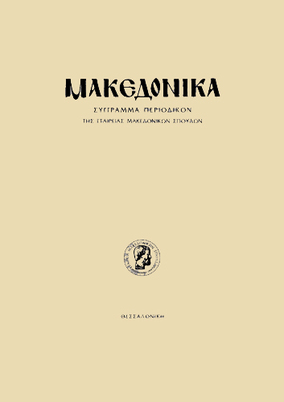Το φαινόμενο της σύνθεσης των οικογενειακών ονομάτων σε δυο χωριά της ορεινής Πιερίας
Part of : Μακεδονικά ; Vol.22, 1982, pages 358-390
Issue:
Pages:
358-390
Parallel Title:
The Phenomenon of the Composition of the Family Names in two Villages of the Mountain Pieria.
Section Title:
Articles
Abstract:
The first part of this study refers to an interesting phenomenon that is registered in two mountainous villages of Pieria, Ritini and Elatohori. The topic of discussion is the composition of the type Ζαχουλάζους, ϋημουκουίός etc., where the family name is the first part of the composition, while the first name is the second.The conditions under which the composition takes place are studied as well as the exceptions that appear because of different reasons, such as psychological and social ones.Afterwards the family names are being examined on the basis of the form and the meaning of their components, and the linguistic phenomena that one can notice in this composition are being indicated.In the second part of the study an attempt is made to give the picture of the composition of family names in the common language and also in the dialects. The composition, as it appears to be after the examination of the compound family names, is of two types : a) the one that has the family name as a first component and the first name as a second, just as the phenomenon appears in the villages of Ritini and Elatohori, for example Μαυρογιώργος, Μαστροδημήτρης etc. and b)the one that has the first name as a first compo nent and the family one as a second one, for example: Σπυρομίλιος, Σηφοδασκαλάκης etc. The compound names of the first type are more than the com pound names of the second one. A comparison is made between the names of the first type registered in different regions which several authors and col lectors o f linguistic material attest, and the names of Ritini and Elatohori, so that the differences and the similarities between them can be seen.Finally a diachronic study of the phenomenon of the composition is made, throughout which is clear that both groups appear in the byzantine time, according to byzantine texts and informations of several scholars. After this, the result comes up that there is a continuance of the phenomenon from the byzantine time to the period of Turkish occupation and up to this day. So, the existence of the phenomenon in these two villages is due either to the continuance of the phenomenon in the same region or to the transference of the phenomenon from another region, where the composition was also known from the byzantine time.
Subject:
Subject (LC):
Notes:
856:https://ejournals.epublishing.ekt.gr/index.php/makedonika/article/view/6090, DOI: https://doi.org/10.12681/makedonika.529
Electronic Resources:




